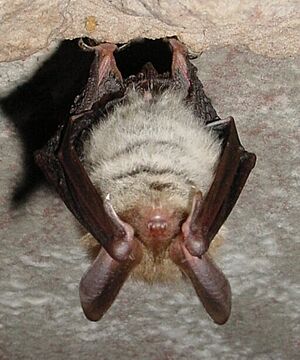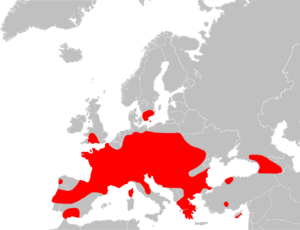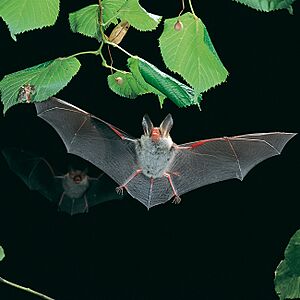Bechstein's bat facts for kids
Quick facts for kids Bechstein's bat |
|
|---|---|
 |
|
| Conservation status | |
| Scientific classification | |
| Genus: |
Myotis
|
| Species: |
bechsteinii
|
 |
|
| Distribution of Bechstein's bat | |
The Bechstein's bat (Myotis bechsteinii) is a special type of bat found across Europe and parts of western Asia. These bats love living in big forests.
Contents
What Does a Bechstein's Bat Look Like?
Bechstein's bats are medium-sized bats with pretty long ears. Their fur is long and fluffy. It's reddish-brown on top and gray-white underneath.
They have a pink face and wide, long ears. Their wings are dark brown and quite wide. The wing membrane connects to the base of their feet. These bats can have a wingspan of up to 30 cm (about 12 inches). Their body, from head to tail, is about 5 cm (2 inches) long.
How Do Bechstein's Bats Live?
Bechstein's bats mainly eat flying insects. They hunt moths, flies, lacewings, and other small bugs that come out at night. Studies of their droppings show they also eat dung flies, grasshoppers, and weevils.
If a group of bats lives far from forests, they might eat insects and spiders found on the ground. Bechstein's bats usually hunt within one or two kilometers of their home. They mostly look for food high up in the forest trees.
Where Do Bechstein's Bats Sleep?
These bats often sleep in holes in trees. They especially like holes made by woodpeckers. Sometimes, they use artificial nest boxes that people put up. They rarely sleep inside human buildings.
In winter, Bechstein's bats go into hibernation. This means they go into a deep sleep underground or in tree holes. They mate in autumn and spring. The babies, usually one per female, are born early the next summer. Groups of mothers with their young often form in late spring.
Where Can You Find Bechstein's Bats?
Bechstein's bats live in many countries. You can find them in places like Austria, France, Germany, Italy, Spain, Sweden, Turkey, and the United Kingdom. They are also found in parts of western Asia, like Armenia and Iran.
In the United Kingdom, these bats are mostly found in southeastern Great Britain. This is the northernmost part of their range. They have been seen in the Forest of Dean and Herefordshire. In 2010, a mother bat was found in Grafton Wood in Worcestershire. This suggested a family of bats was living nearby.
What Kind of Home Do Bechstein's Bats Like?
Bechstein's bats are special because they love living in forests. You almost never find them outside of forested areas. In southwestern Asia, they live in mixed forests. But in Europe, they prefer deciduous forests. These are forests with lots of old trees that lose their leaves in autumn.
They especially like beech and oak woodlands. Sometimes, you might find them in orchards, gardens, or other farmed areas.
Why Are Bechstein's Bats Protected?
Bechstein's bats are protected by a European law called the Habitats Directive. This law helps protect important animals and their homes.
In the UK, this bat is one of the rarest and most endangered species. It's hard to know exactly how many there are, but estimates suggest around 21,600 individuals. Because they are so rare, woodlands where they live might become a Site of Special Scientific Interest. This helps protect their habitat. If you ever see one in the wild, it's important to tell a local bat group or wildlife trust right away.
How Do Bechstein's Bats Use Echolocation?
Bechstein's bats use echolocation to find their way around and hunt. Echolocation is like using sound waves to "see" in the dark. The bats send out high-pitched sounds. These sounds bounce off objects and come back to the bat. The bat then uses these echoes to create a picture of its surroundings.
The sounds these bats make for echolocation are very high-pitched. They range from 35 to 108 kHz. Most of their echolocation sounds are in the 50–60 kHz range. Each sound burst lasts about 3.3 milliseconds.
See also
- Hambach Forest



